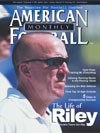AMERICAN FOOTBALL MONTHLY THE #1 RESOURCE FOR FOOTBALL COACHES
Article CategoriesAFM Magazine
|
The Basics:The simple process of getting stronger© More from this issue Initially our routines were very basic. Space, time and equipment were limited when our players trained in the Astrodome. We had 97 players on our roster. We were introducing many of our players to new exercises, new equipment and a new training protocol. We have been changing and adding routines since our relocation from the Astrodome to the Reliant Stadium weight room. We now have more space and equipment, which gives our players additional variety. There is a reason for the exercise sequence of our routines. However, the key to any of our workouts is, and always will be, the quality of each repetition performed and the intensity of each set completed. ....The full article can only be seen by subscribers. Subscribe today!
|
|
|||||||
| HOME |
MAGAZINE |
SUBSCRIBE | ONLINE COLUMNISTS | COACHING VIDEOS |
Copyright 2025, AmericanFootballMonthly.com
All Rights Reserved





